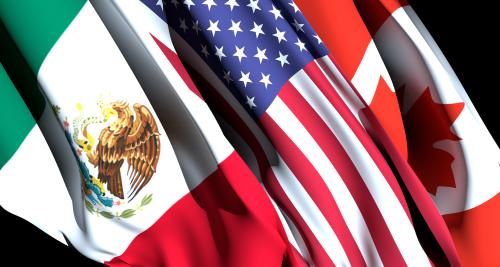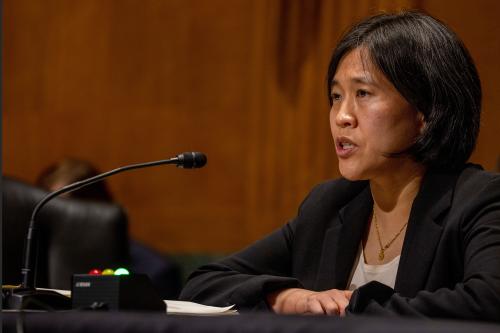In her confirmation hearing, U.S. Trade Representative Katherine Tai stated that “trade is like any other tool in our domestic or foreign policy. It is a means to create more hope and opportunity.” With this in mind, President Biden has made clear that trade must improve wages and create higher-paying jobs for all Americans as he focuses on controlling COVID-19, restoring economic growth and employment, and expanding opportunity by investing in education, R&D, and infrastructure. In this respect, there is no more important regional trade agreement for the U.S. than the United States-Mexico-Canada trade agreement (USMCA).
Why North American trade relations are so important
The significance of USMCA is clear. Canada and Mexico are the United States’ largest export markets: 23 percent of U.S. exports go to Canada and Mexico (versus 5 percent to China), over 70 percent of Mexican exports are sent to the U.S. and Canada, and 62 percent of Canadian exports are to the U.S. and Mexico. Trade among the countries provides key inputs into regional supply chains’ value added (40 percent U.S. value add versus 5 percent China). This is particularly true in the auto sector, which dominates manufactured trade between all three countries. The importance of resilient supply chains has also been made abundantly clear in light of the impact of COVID-19, and as competition with China exposes vulnerabilities to relying on Chinese supply chains. The Biden administration has ordered a review of U.S. supply chains, with the objective of decreasing American dependence on Chinese production of critical inputs. Integrated North American supply chains could provide a viable alternative to Chinese manufacturing and allow some critical industries to move production closer to home.
The U.S., Canadian, and Mexican governments should use USMCA as the backbone for a renewed vision of North American competitiveness.
A new beginning
The Biden administration has signaled that one of its priorities will be strengthening diplomatic relationships with America’s traditional allies, including Canada and Mexico. Following Trump’s “America First” approach, an early and visible commitment to strengthening the economic relationship between the three North American partners would be a welcome signal that the Biden administration will prioritize alliance diplomacy.
The USMCA builds on the North American Free Trade Agreement (NAFTA), which first integrated the region’s economies when it came into effect in 1994, but also presents a new template for North American relations. USMCA was the first free trade agreement backed by the AFL-CIO labor union and it passed the Senate with overwhelming bipartisan support (89-10 compared with 60-38 for NAFTA in 1993). This support underscores the agreement’s potential for rebuilding consensus on how to advance economic integration consistent with good jobs, growing wages, strong labor standards, and environmental protection. To maintain broad political support, however, the Biden administration will need to continually engage, both domestically and with partners in Canada and Mexico, to ensure USMCA is delivering on its promise. The USMCA sunset clause requiring joint review and agreement on renewal in year 6 of the agreement provides added urgency to getting the USMCA right.
More than NAFTA
USMCA builds on NAFTA in ways that underscore how much international trade policy has shifted from a focus on tariffs to nontariff regulatory issues. In fact, USMCA largely keeps NAFTA’s tariff rates, retaining tariff free U.S.-Mexico trade and including some further market access improvements with respect to U.S.-Canada trade.
The USMCA addresses regulatory differences that create unnecessary barriers to trade. It also rebalances rights and obligations, rolling back some commitments, such as access to investor-state dispute settlements (ISDS), and strengthening commitments in support of labor rights, environmental standards, and small businesses. Stricter rules of origin for autos that require 75 percent local content (up from 62.5 percent under NAFTA) should also create incentives for domestic manufacturing, another potential win for workers.
An early focus on implementation and compliance is needed
How the USMCA works in practice will be key to sustaining the high level of bipartisan support. The most immediate need is for all governments to fully implement and comply with the agreement. The Trump years undermined other governments’ faith in U.S. commitment to the rule of law, which also undermined the business certainty these agreements are meant to provide. Indeed, the United States International Trade Commission (USITC) identified reduced investor uncertainty, highlighting the importance of compliance by all governments if the benefits of USMCA are to be realized. Strict U.S. compliance at home, combined with a willingness to use USMCA enforcement tools to address compliance issues in Mexico and Canada, can help restore faith in the U.S. government’s commitment and signal that business can rely on the agreement when making decisions to trade and invest.
The administration also needs to invest in making the agreement’s many committees productive and dynamic, using these institutional mechanisms to give the effect of a living agreement. For example, a new Competitiveness Committee will bring together officials from the three countries to assess the implementation and identify scope for further integration to increase regional competitiveness. Furthermore, it creates opportunities for the partners to continually review and update their associated trade and investment policies—but only if governments meaningfully invest in the process.
As noted, USMCA also includes a “joint review” mechanism, which calls for the three countries to come together every six years to identify where the agreement is succeeding and where it is falling short. The review mechanism was controversial during the negotiations, as critics worried it would introduce greater uncertainty and could be used as pretext for a government to pull out of the deal. Yet the ultimate impact of the review mechanism will depend on how governments use it: whether they approach it not as a chance to air grievances and threaten withdrawal but as an opportunity for ensuring the trade agreement is functioning effectively.
The new USMCA monitoring, research, and engagement project at Brookings will track where the agreement is delivering and identify areas where improvements are needed.
Ultimately, the U.S., Canadian, and Mexican governments should use USMCA as the backbone for a renewed vision of North American competitiveness, helping the three partners align their economic strategies and interests amid a shifting global political economy. Yet, such an outcome will not simply spontaneously emerge because the trade deal is in place. Rather, it will require ongoing commitment, attention, and (where necessary) adjustment from leaders. This is one of the reasons why we intend to closely follow the USMCA implementation over the coming years.
The new USMCA monitoring, research, and engagement project at Brookings will track where the agreement is delivering and identify areas where improvements are needed. We will leverage our convening power to bring to the table key stakeholders—the U.S. administration and Congress, leading government officials and legislators in Canada and Mexico, business, labor, and civil society—on specific issues such as impact on labor rights and wages, support for digital trade, and how USMCA strengthens (or not) North American supply chains. We will monitor progress and present policy options for strengthening the agreement.
At one of the first roundtables convened at Brookings earlier this month, senior business, academic, and civil society representatives from the U.S., Mexico, and Canada stressed the importance of USMCA for North American competitiveness, particularly amid a post-COVID-19 push to build more resilient regional supply chains. But they also noted some potential stumbling blocks, pointing to the need for increased government engagement.
In the coming months, ensuring effective implementation and high compliance with the agreement will be critical and will require policymakers’ ongoing time and attention. Former Secretary of State George Schultz used to compare diplomacy to gardening: Successful diplomacy requires continual tending, pulling weeds before they overwhelm the fertile ground. Trade relationships require similar attention from policymakers—checking in with partners, addressing irritants before they become lingering disputes, coming up with strategies to address new shared challenges, and building on the successes that create more hope and opportunity for all.
The Brookings Institution is committed to quality, independence, and impact.
We are supported by a diverse array of funders. In line with our values and policies, each Brookings publication represents the sole views of its author(s).






Commentary
The importance of USMCA for the Biden administration’s economic and foreign policy
April 28, 2021